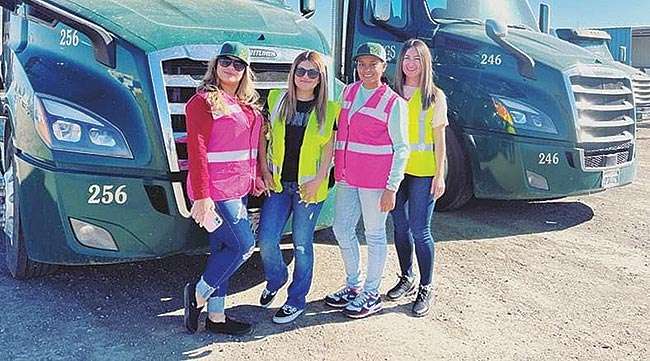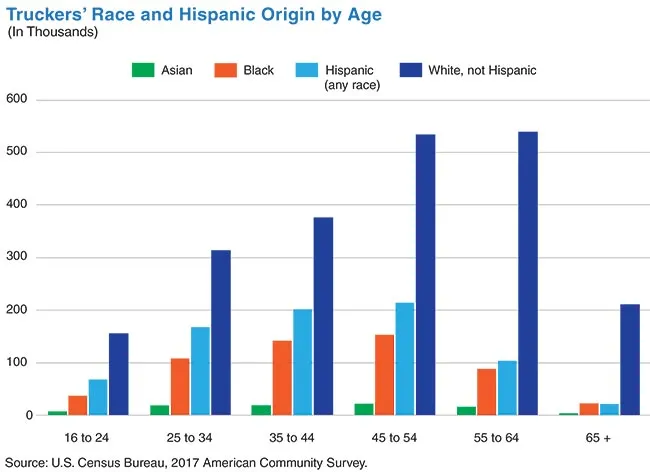Special to Transport Topics
Fleets Use Tech to Aid Communication With Immigrant Drivers

[Stay on top of transportation news: Get TTNews in your inbox.]
American Trucking Associations says the industry is short 78,000 truck drivers. A number of companies have filled some of those jobs by hiring more immigrant drivers.
Immigrants make up 18.6% of employed drivers according to 2020 Bureau of Labor statistics, slightly higher than the 17% in overall U.S. labor. BLS reported that the number of foreign-born truck drivers more than doubled from 2000 at 315,981 to more than 720,000 in 2021. The increase represents a continual change in the makeup of the labor pool of truck drivers, creating significant language challenges throughout the industry.
Truck driving jobs are attractive to many immigrants, both male and female, because of fewer layoffs and a higher pay scale than in other blue-collar jobs. However, with the number of immigrants employed in truck driving increasing — many of whom speak English as a second language — some trucking companies have run into language barrier challenges.
The use of technology-based programs is helping integrate non-native English speakers into truck driving environments. Similar technology helps assure accuracy of load pickup and delivery in settings where verbal communications may be easily misunderstood.
From onboarding to daily operations, meeting those language challenges is key to an efficient operation. BLS expects a truck driving job growth rate of 6% through 2030, with California having a projected growth rate of 15% and New Jersey 10%. Overcoming language barrier challenges in addition to traditional trucking operational issues is essential to meeting customer delivery expectations and retaining drivers.

California-based TGS, with offices in Fresno as well as Reno, Nev., employs a high number of truck drivers whose first language is Spanish. The trucking company handles international drayage while servicing the ports of Los Angeles, Long Beach and Oakland, as well as intermodal drayage from Lathrop, Stockton, Oakland and Reno ramps.
Chief Operating Officer Robert Loya noted that while language isn’t really a barrier in TGS operations, technology can help reduce misunderstandings.
“With the high number of bilingual employees and customers in our area of southern California, language isn’t really a barrier, but technology allows us to communicate with fewer misunderstandings,” he said. “Containers are often picked up and delivered in very noisy environments, which sometimes makes verbal communication difficult to understand, and even with bilingual drivers, misunderstanding could easily occur.”

Loya
Loya added that there’s only so much information that drivers need for their pickups and deliveries.
“Having all needed information on their phones allows drivers to have correct information at hand,” he added.
In a state with the highest projected truck driver job growth, recognizing the implications of language barrier challenges is a growing priority. Another California fleet, Young’s Commercial Transfer, focuses on addressing language barriers and takes a companywide approach of message targeting and an assertive response to any issue. Young’s, established in 1935, is a bulk agricultural products carrier that specializes in moving loads of fruits and vegetables from the fields to the first point of processing, and has 400 trucks and nearly 3,000 trailers.

Gong
With changing demographics, cultural awareness will follow, said Johnathan Gong, the fleet’s safety and compliance director. “We pride ourselves on a diverse workforce,” he said. “We advertise and promote such drivers on social media. We have multiple terminals where our female-to-male driver ratio is [50-50].”
Young’s staffs bilingual teams to assist with onboarding, safety and dispatch. Orientation is conducted in multiple languages.
The fleet has partnered with vendors such as Luma Brighter Learning, which provides training programs in 12 different languages; Avatar Fleet, a software provider dedicated to driver recruitment and compliance; and Samsara for Spanish-language translation for electronic logging. Drivers also set up automatic translation on phones for email or text, and use WhatsApp or FaceTime to send photos.
While technology-based systems provide tools to assist with common operations, they become even more useful when an issue need immediate attention.
Want more news? Listen to today's daily briefing above or go here for more info
Language barriers are challenges for both drivers and managers, and failing to deal with them can turn minor disruptions into heated arguments rather quickly. Gong emphasized the importance of promptly resolving any issue. “Action is key,” he said. “Harassment of any kind has no place in the modern workforce and is not tolerated. Any issue is addressed right away.”
Gong emphasized the importance of managing any language challenges as driver demographics continue to shift.
“For the majority of our drivers, English is not their first language, and this does provide a different set of challenges in onboarding and day-to-day operations,” said Gong. “The days of a 55-year-old white male [dominating the truck driver population] are slowly coming to an end. Look at the 22-year-old, female driver from El Salvador, who is just as capable, as experience is gathered.”




